Kaya Mahy
Key Words
- Buddhism
- Goryeo
- Korea
- Religion
- Festivals
- Temples
- Rituals
- Aristocracy
- King Taejo
The Goryeo period (918-1392) was known for many components of Korean history, namely religious passion and an increase in practices.[1] This time period was pivotal for the development of religions and ways of expression. The Goryeo period in Korea encompassed various religions and ways of expression, however, Buddhism was the most prevalent.
Buddhism: Background
What is Buddhism? As with any religion, this is a complicated answer. There are many different elements to Buddhism and it is not the same to every individual who practices or believes in it. Buddhism’s religious founder was the Buddha (c. 5th to 4th century BCE) and he conveyed his teachings to people who followed him. These teaching later became known as Buddhism. The essential teaching that Buddha expressed is that life’s purpose is to achieve enlightenment. (Buddha means “the enlightened one, aware”.) Other important teachings include that selfishness results in suffering and the only way to heal from the suffering is to follow the Eightfold Path. The Eightfold Path consists of having the right view, right thought, right speech, right action, right work, right effort, right attention, and right concentration. If the teachings of the Buddha are followed, it is believed that one will reach enlightenment.[2]
Despite the popularity of Buddhism in Korea, that is not where the religion originated. Buddhism dates back to around 560 BCE, the birth year of Buddha. His death was roughly 480 BCE. Buddhism was first introduced from the foothills of the Himalayas to Sri Lanka, next making its way to Central Asia. The religion spread to China and then to Southeast Asia. It was not until about 300 CE that Buddhism finally reached Korea. This extension of the religion came unintentionally from ships from Korea traveling to China. Through this, Chinese art and technologies, accompanied by religious ideas, were passed along.[3] Between Buddhism’s first arrival in Korea and the Goryeo period, the religion developed and became a large part of Korea’s culture and people’s way of life.[4]
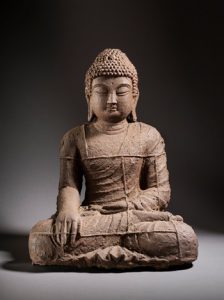
Buddhism in the aristocracy
During the Goryeo period, the aristocracy and state were highly supportive of Buddhism. The Buddhist arts and architecture grew the most in this period because of that support. The aristocracy’s involvement included royals participating in Buddhist rituals. As a matter of fact, all Buddhist rituals were linked to the state in some way.[5] The state was predominantly responsible for embracing Buddhism so that it would be transmitted to the people.[6]
Taejo of Goryo
Taejo Wang Geon, the first king of Goryeo (ruled 918 to 943) was responsible for building numerous temples during his reign and thirteen in the capital alone.[7] Taejo founded temples in the capital to add substance to his new dynasty, and used them for many functions at the heart of his dynastic project.[8]
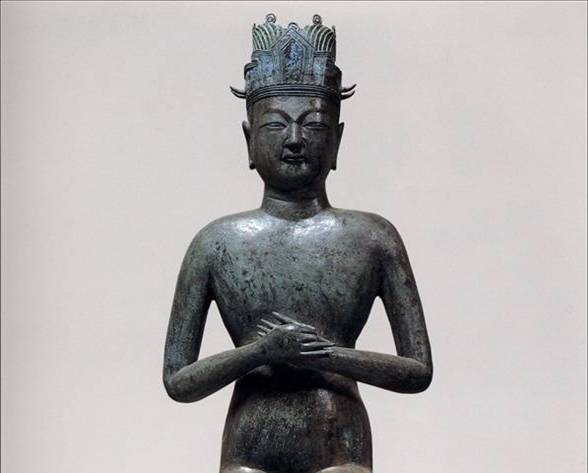
Temples
Buddhist temples were a large aspect of the Buddhist religious expression for Koreans during the Goryeo period. Temples were utilized for housing the portraits of kings who recently passed away. Buddhist temples were the focal point for the royal ancestor worship throughout this time period. The halls of the kings’ portraits were usually referred to as jinjeon, or “true likeness halls.” A Buddhist tradition in Korea is that on the anniversaries of a king’s death, a ceremony is carried out at the jinjeon. The first memorial temple was Bongeun-sa (sa means temple) . Bongeun-sa was the memorial temple for Taejo and was established by King Gwangjong in 951. What is ironic about this temple is that Taejo made it a command that his successors could not build memorial temples for themselves, even though one was later made for him.
Following Bongeun-sa, memorial shrines were constructed for all kings, queens, and non-reigning fathers of kings.[9] Also within 951, King Kwangjong made Bulil-sa as a memorial temple for Taejo’s Queen Yu. Kings who preceded Taejo would visit Bongeun-sa on Taejo’s death day and on the days of the Lantern Festival (discussed later on). Bongeun-sa was the location for royal and state preceptors to be named and for kings to pray in front of Taejo’s picture, as well.[10] Bongeun-sa was the most cherished and significant memorial temple in Korea. An interesting fact is there were only about twenty other identifiable memorial Korean temples as the others simply lacked information.[11] The locations of the temples were never random, A Buddhist belief from the Injunctions of king Taejo[12] was that if they had been random, the temples would damage the veins of the earth. Hence, temples were to only be built in locations approved and chosen by the monk Toson.[13] The Korean devotion to royal ancestors in Buddhist temples is a clearly important component of the Goryeo period. Some believe that Goryeo paintings in temples propose that praying to them led to good rebirth in the royal family.[14]
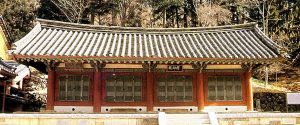
Buddhist festivals and rituals
Palgwanhoe (also known as the festival of the Eight Vows or Injunctions or Commandments) was one of the great festivals that was a state ritual. It was considered a state ritual because the king and officials would join in the activities, as well as some normal civilians.[15] Another festival, the Yeondeunghoe or the Lantern Festival, was just as expansive and popular in Korea as Palgwanhoe. They both were events found on the Korean calendar, but the difference between the two is that the Lantern Festival held more Buddhist nature. Yeondeunghoe celebrated Buddha’s birthday, with the lighting of lamps representing a merit-producing behavior.[16] Aside from those two of the most known Korean Buddhist festivals, the Humane Kings Assembly was a ritual that can be debated as being the most important state ritual. The Humane Kings Assembly was held either bi- or triennially, or whenever needed. This ritual was the oldest established state ritual in Korea and therefore viewed as the most successful ritual device in disasters by the Goryeo court.[17] It is noteworthy that besides the two large festivals, Palgwanhoe and Yeondeunghoe, Buddhist rituals are mostly for the partaking of royalty and officials only.[18] “Ordinary” people, outside of the state or aristocracy, are mainly uninvolved in the festivals due to the fact that most rituals took place in the palace. It is thought that as a result of this norm, ritual space was dominated by the court.
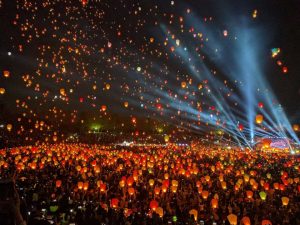
There was a large variety of rituals during Goryeo Korea, with about 100 different types.[19] In almost every month there was at least one Buddhist event for a king to attend, emphasizing the significance of the religion in a king’s obligations. For an outsider, the Buddhist events are hard to understand. There was typically no explanation for why a ritual was conducted and what took place during them, in addition to whether or not the ritual was even regarded as Buddhist. Often it was not discussed what a king did when he had a temple visit.[20]
Below is a list of the rituals that were completed by King Munjong in 1046, for a year. It illustrates what a typical year of rituals looked like for a king during Goryeo Korea.
- 1046, 5th month, jeongyu day (18th day): enthroned
- 07.01: went to Wangnyun-sa for mother’s memorial rite
- 08.05: organized a Hwaeom assembly in the Geondeok Hall of the palace
- 09.02: went to Boje-sa, gave meal to monks
- 09.08: organized a Hundred Seat Assembly [based on the Humane Kings Sutra] in the palace, lasts three days.
- 09.29: went to Myotong-sa, offered incense
- 10.10: organized a Calamities-Dispelling ritual (Sojae doryang) in the Hoegyeong Hall of the palace
- 11.14: organized Palgwanhoe, [afterward] went to Beopwang-sa
- 12.30: officials gathered in Geondeok Hall to congratulate king on his birthday; every year on the king’s birthday the state organized an assembly to pray for blessings (gilsang yeongbok doryang) in the Oejeseog-won for seven days; civil and military bureaucrats held the ceremony in Heungguk-sa and in temples across the country
- 1047, 2nd month, 14th day: Lantern Festival. King went to Bongeun-sa-sa, following day feasted with relatives and ministers
- 02.27: went to Oejeseog-won
- 03.09: personally held Prajñāparamitā [sutra] assembly in Geondeok Hall for five days
- 04.17: personally held Hundred Seat Assembly in Hoegyeong Hall, fed 10,000 monks on the polo court [21]
How religion and spirituality aided Korea’s climate
Buddhism and spirituality were in some circumstances used to assist with issues outside of the human self, but tackle problems with the greater world. One example was that rituals and prayer were utilized to attempt to alter the climate. Goryeo Korea was a tough period climate-wise. They experienced rain and drought throughout the dynasty. This was when kings took it upon themselves to perform rituals that were believed to lead to pleasant weather conditions. Having pleasant weather conditions would make for better agriculture and harvesting in Korea, a large contributor to Goryeo Korea’s wealth and economy.
The kings carrying out these rituals were given spiritual power. To be ready for the summer monsoons, rain prayers began annually in the second or third months. Kings prayed to gods of mountains and streams in order to sustain the approval of Heaven. If the prayers were unsuccessful and there was little or no rain, the kings resorted to personal, private, and public ritual choices, such as, staying clear of the main throne hall and minimizing the number of side dishes during meals.[22]
Conclusion
From the time of Buddhism’s introduction in Korea to now, the ideals and traditions of the religion have shown great significance. During Goryeo Korea, the immense engagement from those of higher power and the aristocracy shows how respected the religion was. Plus, even though the aristocracy no longer remains, the respect for Buddhism in Korea lives on. The value of the Buddhist temples and the amount of events that took place in the temples throughout a year is further proof of Buddhism’s worth in Korea. To many Koreans, Buddhism was more than a religion, but a way of life and was utilized to solve other life occurrences. Overall, Buddhism is a huge aspect of Korean culture, in part due to its development during the Goryeo period.
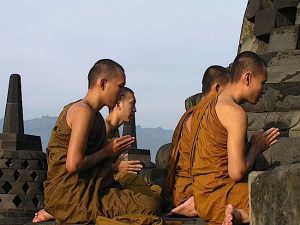
Suggestions for Further Research
- Other religions that are present in Korea (Confucianism, Christianity, etc.)
- Daily lives of everyday Buddhist Koreans
- How Buddhism has changed in Korea since the Goryeo period
Bibliography
Asia Society. “Historical and Modern Religions of Korea.” https://asiasociety.org/education/historical-and-modern-religions-korea.
Cartwright, Mark. “Goryeo.” World History Encyclopedia (website), October 17, 2016. https://www.worldhistory.org/Goryeo/.
Hawkins, Bradley K. Buddhism.Religions of the World. London: Routledge, 1999.
Kahm, Howard, and Dennis Lee. “Begging for Rain: Economic and Social Effects of Climate in the Early Koryŏ Period.” Journal of Korean Studies 26, no. 1 (2021): 3–23.
Kalman, Bobbie. What Is Religion? Our Multicultural World. New York: Crabtree Pub., 2009.
Vermeersch, Sem. “Buddhism at the Center: The Temples of Kaesŏng and Their Socio-Political Role.”Acta Koreana 7, no. 2 (2004): 7–34.
———. The Power of the Buddhas: The Politics of Buddhism during the Koryo Dynasty (918-1392). Cambridge, Mass.: Harvard University Asia Center Publications Program, 2008.
- Mark Cartwright, “Goryeo,” World History Encyclopedia, October 17, 2016, https://www.worldhistory.org/Goryeo/. ↵
- Bobbie Kalman, What Is Religion?, Our Multicultural World (New York: Crabtree Pub., 2009), 24-25. ↵
- Bradley K. Hawkins, Buddhism, Religions of the World (London: Routledge, 1999), 57. ↵
- Hawkins, Buddhism, 10. ↵
- “Historical and Modern Religions of Korea,” Asia Society (website), https://asiasociety.org/education/historical-and-modern-religions-korea. ↵
- Sem Vermeersch, “Buddhism at the Center: The Temples of Kaesong and Their Socio-Political Role,” Acta Koreana 7, no. 2 (2004): 8. ↵
- Versmeersch, "Buddhism at the Center," 10. ↵
- Versmeersch, "Buddhism at the Center," 12. ↵
- Versmeersch, "Buddhism at the Center," 13. ↵
- Sem Vermeersch, The Power of the Buddhas: The Politics of Buddhism during the Koryo Dynasty (918-1392) (Cambridge, Mass.:Harvard University Asia Center Publications Program, 2008), 342. ↵
- Vermeersch, "Buddhism at the Center," 16. ↵
- This refers to Taejo’s Ten Injunctions, and more specifically, the reference to the “veins of the earth”. This is different to the Eight (Buddhist) Injunctions discussed later. ↵
- Vermeersch, "Buddhism at the Center," 11. ↵
- Vermeersch, The Power of the Buddhas, 348. ↵
- Vermeersch, The Power of the Buddhas, 318. ↵
- Vermeersch, The Power of the Buddhas, 324. ↵
- Vermeersch, The Power of the Buddhas, 327. ↵
- Vermeersch, The Power of the Buddhas, 333. ↵
- Vermeersch, "Buddhism at the Center," 18. ↵
- Vermeersch, The Power of the Buddhas, 321. ↵
- Vermeersch, The Power of the Buddhas, 320. ↵
- Howard Kahm and Dennis Lee, “Begging for Rain: Economic and Social Effects of Climate in the Early Koryŏ Period,” Journal of Korean Studies 26, no. 1 (2021): 5. ↵
